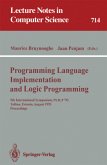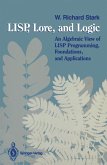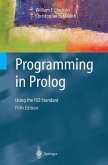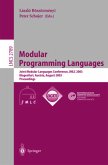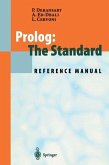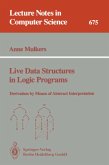This workbook is for programmers who are new to Prolog and who wish to write useful Prolog programs. The emphasis is on a simplified and disciplined methodology for discerning the mathematical structures related to a problem, and then turning these structures into Prolog programs. A relatively pure subset of Prolog is used and the focus is not on particular features of the language. The presentation is novel. An outline of basic concepts is interleaved with worksheets, which are graduated in scope and give guidance for practising new ideas. Extended examples in the form of case studies then apply the ideas. The book can be a useful companion to two other Springer books, as a sequel to the author's introductory text "Programming in Prolog" and alongside the reference manual "Prolog: The Standard".
This book is for people who have done some programming, either in Prolog or in a language other than Prolog, and who can find their way around a reference manual. The emphasis of this book is on a simplified and disciplined methodology for discerning the mathematical structures related to a problem, and then turning these structures into Prolog programs. This book is therefore not concerned about the particular features of the language nor about Prolog programming skills or techniques in general. A relatively pure subset of Prolog is used, which includes the 'cut', but no input/output, no assert/retract, no syntactic extensions such as if then-else and grammar rules, and hardly any built-in predicates apart from arithmetic operations. I trust that practitioners of Prolog program ming who have a particular interest in the finer details of syntactic style and language features will understand my purposes in not discussing these matters. The presentation, which I believe is novel for a Prolog programming text, is in terms of an outline of basic concepts interleaved with worksheets. The idea is that worksheets are rather like musical exercises. Carefully graduated in scope, each worksheet introduces only a limited number of new ideas, and gives some guidance for practising them. The principles introduced in the worksheets are then applied to extended examples in the form of case studies.
Hinweis: Dieser Artikel kann nur an eine deutsche Lieferadresse ausgeliefert werden.
This book is for people who have done some programming, either in Prolog or in a language other than Prolog, and who can find their way around a reference manual. The emphasis of this book is on a simplified and disciplined methodology for discerning the mathematical structures related to a problem, and then turning these structures into Prolog programs. This book is therefore not concerned about the particular features of the language nor about Prolog programming skills or techniques in general. A relatively pure subset of Prolog is used, which includes the 'cut', but no input/output, no assert/retract, no syntactic extensions such as if then-else and grammar rules, and hardly any built-in predicates apart from arithmetic operations. I trust that practitioners of Prolog program ming who have a particular interest in the finer details of syntactic style and language features will understand my purposes in not discussing these matters. The presentation, which I believe is novel for a Prolog programming text, is in terms of an outline of basic concepts interleaved with worksheets. The idea is that worksheets are rather like musical exercises. Carefully graduated in scope, each worksheet introduces only a limited number of new ideas, and gives some guidance for practising them. The principles introduced in the worksheets are then applied to extended examples in the form of case studies.
Hinweis: Dieser Artikel kann nur an eine deutsche Lieferadresse ausgeliefert werden.



